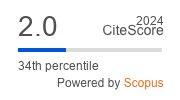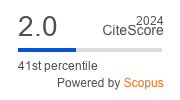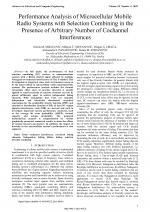| 4/2010 - 1 | View TOC | « Previous Article | Next Article » |
| Extra paper information in |
| Click to see author's profile in |
| Download PDF |
Author keywords
cochannel interference, correlated fading channels, Nakagami-m fading, Rician fading, selection diversity combining
References keywords
fading(15), channels(13), selection(9), correlated(9), stefanovic(8), radio(8), interference(8), cochannel(8), analysis(8), rician(7)
Blue keywords are present in both the references section and the paper title.
About this article
Date of Publication: 2010-11-30
Volume 10, Issue 4, Year 2010, On page(s): 3 - 8
ISSN: 1582-7445, e-ISSN: 1844-7600
Digital Object Identifier: 10.4316/AECE.2010.04001
Web of Science Accession Number: 000284782700001
SCOPUS ID: 78649715860
Abstract
In this paper, the performance of dual selection combining (SC) receiver in communications systems with a Rician desired signal affected by multiple Nakagami-m cochannel interferences (CCIs) is studied. This investigation is important since such environment seems to be the most realistic in microcellular radio communications systems. The performance analysis includes the channel correlation effect since in practice diversity is usually applied in small terminals so antenna elements can not be placed sufficiently apart to achieve independent fading channels. With assumption that CCIs are mutually independent and identically distributed, analytical expressions for the probability density function (PDF) and cumulative distribution function (CDF) of dual SC output signal-to-interference ratio (SIR) are derived and used to investigate important system performance measures, such as the average bit error probability (ABEP), channel capacity and outage probability. The proposed mathematical analysis is complemented by various graphically presented numerical results to show the effects of various system's parameters. In addition, the impact of diversity to the microcellular system's performance is also explored. |
| References | | | Cited By «-- Click to see who has cited this paper |
| [1] J. D. Parsons, The Mobile Radio Propagation Channels, 2nd ed. New York: Wiley, 2000. [CrossRef] [2] A. Goldsmith, Wireless Communications, Cambridge University Pres: New York, 2005. [PermaLink] [3] M. K. Simon and M.-S. Alouini, Digital Communication over Fading Channels, 1st ed. New York: Wiley, 2000. [CrossRef] [4] S. Okui, "Effects of SIR selection diversity with two correlated branches in the m-fading channel," IEEE Trans. Commun., vol. 48, no. 10, pp. 1631-1633, Oct. 2000. [CrossRef] [SCOPUS Times Cited 50] [5] A. S. Panajotovic, M. C. Stefanovic, D. Lj. Draca, and N. M. Sekulovic, "Average level crossing rate of dual selection diversity in correlated Rician fading with Rayleigh cochannel interference," IEEE Commun. Lett., vol. 14, no. 7, pp. 1-3, Jul. 2010. [CrossRef] [SCOPUS Times Cited 19] [6] J. Winters, "Optimum combining in digital mobile radio with cochannel interference," IEEE J. Sel. Areas in Commun., vol. 2, no. 4, pp. 528-539, Jul. 1984. [CrossRef] [SCOPUS Times Cited 645] [7] G. K. Karagiannidis, "Performance analysis of SIR-based dual selection diversity over correlated Nakagami-m fading channels," IEEE Trans. Veh. Technol., vol. 52, no. 5, pp. 1207-1216, Sept. 2003. [CrossRef] [SCOPUS Times Cited 90] [8] M. C. Stefanovic, D. M. Milovic, A. M. Mitic, and M. M. Jakovljevic, "Performance analysis of system with selection combining over correlated Weibull fading channels in the presence of cochannel interference," Int. J. Electron. Commun. (AEU), vol. 62, no. 9, pp. 695-700, Oct. 2008. [CrossRef] [SCOPUS Times Cited 50] [9] A. S. Panajotovic, M. C. Stefanovic, and D. Lj. Draca, "Performance analysis of system with selection combining over correlated Rician fading channels in the presence of cochannel interference," Int. J. Electron. Commun. (AEU), vol. 63, no. 12, pp. 1061-1066, Dec. 2009. [CrossRef] [SCOPUS Times Cited 24] [10] M. C. Stefanovic, D. Lj. Draaa, A. S. Panajotovic, and N. M. Sekulovic, "Performance analysis of system with L-branch selection combining over correlated Weibull fading channels in the presence of cochannel interference," Int. J. Commun. Syst., vol. 23, no. 2, pp. 139-150, Feb. 2010. [CrossRef] [SCOPUS Times Cited 29] [11] A. S. Panajotovic, M. C. Stefanovic, and D. Lj. Draca, "Effect of microdiversity and macrodiversity on average bit error probability in shadowed fading channels in the presence of interference," ETRI J., vol. 31, no. 5, pp. 500-505, Oct. 2009. [CrossRef] [SCOPUS Times Cited 16] [12] D. Aleksic, N. Sekulovic, and M. Stefanovic, "Outage probability of system with selection combining over correlated Weibull fading channels in the presence of Rayleigh cochannel interference," Elektron. Elektrotech., vol. 90, no. 2, pp. 7-10, 2009. [13] P. Spalevic, N. Sekulovic, Z. Georgios, and E. Mekic, "Performance analysis of SIR-based triple selection diversity over correlated Weibull fading channels," Facta Universitatis: Series Electronics and Energetics, vol. 23, no. 1, pp. 89-98, Apr. 2010. [14] N. Sekulovic, M. Stefanovic, D. Denic, and D. Aleksic, "Performance analysis of SINR-based selection diversity over correlated Rayleigh fading channels," IET Commun., accepted for publication, [CrossRef] [SCOPUS Times Cited 7] [15] K. W. Sowerby and A. G. Williamson, "Outage probability calculations for a mobile radio system having multiple Rayleigh interferers," Electron. Lett., vol. 23, no. 11, pp. 600-601, May 1987. [CrossRef] [SCOPUS Times Cited 24] [16] Y.-D. Yao and A. U. H. Sheikh, "Investigations into cochannel interference in microcellular mobile radio systems," IEEE Trans. Veh. Technol., vol. 41, no. 2, pp. 114-123, May 1992. [CrossRef] [SCOPUS Times Cited 182] [17] R. J. C. Bultitude and G. K. Bedal, "Propagation characteristics on microcellular urban mobile radio channels at 910 MHz," IEEE J. Sel. Areas in Commun., vol. 7, no. 1, pp. 31-39, Jan. 1989. [CrossRef] [SCOPUS Times Cited 173] [18] Y.-D. Yao and A. U. H. Sheikh, "Outage probability analysis for microcell mobile radio systems with cochannel interferers in Rician/Rayleigh fading environment," Electron. Lett., vol. 26, no. 13, pp. 864-866, Jun. 1990. [CrossRef] [SCOPUS Times Cited 163] [19] G. Karagiannidis, S. Kotsopoulos, and C. Georgopoulos, "Outage probability analysis for a Rician signal in L Nakagami-m interferers with arbitrary parameters," J. Commun. Networks, vol. 1, no. 1, pp. 26-30, Mar. 1999. [20] V. V. Milenkovic, N. M. Sekulovic, M. C. Stefanovic, and M. B. Petrovic, "Effect of microdiversity and macrodiversity on average bit error probability in gamma shadowed Rician fading channels," ETRI J., vol. 32, no. 3, pp. 464-467, Jun. 2010. [CrossRef] [SCOPUS Times Cited 26] [21] M. K. Simon, "Comments on "Infinite-series representations associated with the bivariate Rician distribution and their applications," " IEEE Trans. Commun., vol. 54, no. 8, pp. 1511-1512, Aug. 2006. [CrossRef] [SCOPUS Times Cited 27] [22] A. A. Abu-Dayya and N. C. Beaulieu, "Outage probabilities of cellular mobile radio systems with multiple Nakagami-m interferers," IEEE Trans. Veh. Technol., vol. 40, no. 4, pp. 757-768, Nov. 1991. [CrossRef] [SCOPUS Times Cited 155] [23] M. Nakagami, "The m-distribution - A general formula of intensity distribution of rapid fading," in Statistical Methods in Radio Wave Propagation, Pergamon Press, Oxford, U.K., pp. 3-36, 1960. [PermaLink] [24] M. Abramovitz and I. A. Stegun, "Handbook of Mathematical Functions with Formulas, Gaphs, and Mathematical Tables", New York: Dover publications Inc., 1970. [25] I. S. Gradshteyn and I. M. Ryzhik, "Table of Integrals, Series, and Products", 5th ed. New York: Academic, 1994. [PermaLink] [26] A. A. Abu-Dayya and N. C. Beaulieu, "Microdiversity on Rician fading channels," IEEE Trans. Commun., vol. 42, no. 6, pp. 2258-2267, Jun. 1994. [CrossRef] [SCOPUS Times Cited 67] Web of Science® Citations for all references: 0 SCOPUS® Citations for all references: 1,747 TCR Web of Science® Average Citations per reference: 0 SCOPUS® Average Citations per reference: 65 ACR TCR = Total Citations for References / ACR = Average Citations per Reference We introduced in 2010 - for the first time in scientific publishing, the term "References Weight", as a quantitative indication of the quality ... Read more Citations for references updated on 2025-06-30 23:48 in 126 seconds. Note1: Web of Science® is a registered trademark of Clarivate Analytics. Note2: SCOPUS® is a registered trademark of Elsevier B.V. Disclaimer: All queries to the respective databases were made by using the DOI record of every reference (where available). Due to technical problems beyond our control, the information is not always accurate. Please use the CrossRef link to visit the respective publisher site. |
Faculty of Electrical Engineering and Computer Science
Stefan cel Mare University of Suceava, Romania
All rights reserved: Advances in Electrical and Computer Engineering is a registered trademark of the Stefan cel Mare University of Suceava. No part of this publication may be reproduced, stored in a retrieval system, photocopied, recorded or archived, without the written permission from the Editor. When authors submit their papers for publication, they agree that the copyright for their article be transferred to the Faculty of Electrical Engineering and Computer Science, Stefan cel Mare University of Suceava, Romania, if and only if the articles are accepted for publication. The copyright covers the exclusive rights to reproduce and distribute the article, including reprints and translations.
Permission for other use: The copyright owner's consent does not extend to copying for general distribution, for promotion, for creating new works, or for resale. Specific written permission must be obtained from the Editor for such copying. Direct linking to files hosted on this website is strictly prohibited.
Disclaimer: Whilst every effort is made by the publishers and editorial board to see that no inaccurate or misleading data, opinions or statements appear in this journal, they wish to make it clear that all information and opinions formulated in the articles, as well as linguistic accuracy, are the sole responsibility of the author.



